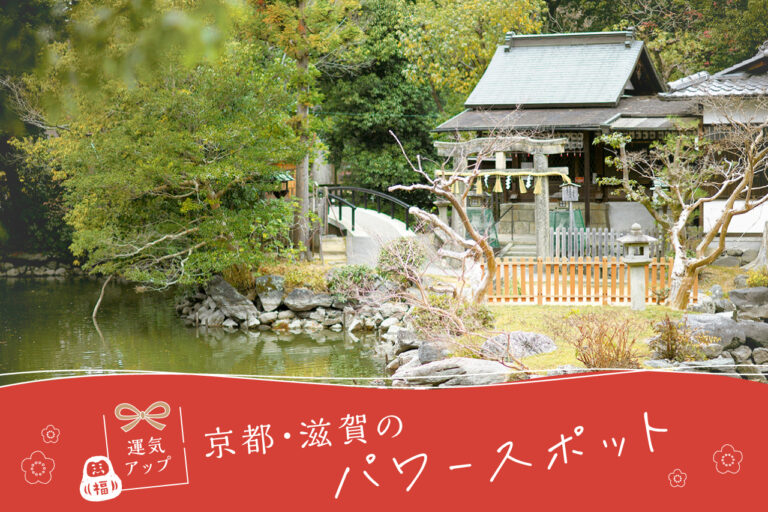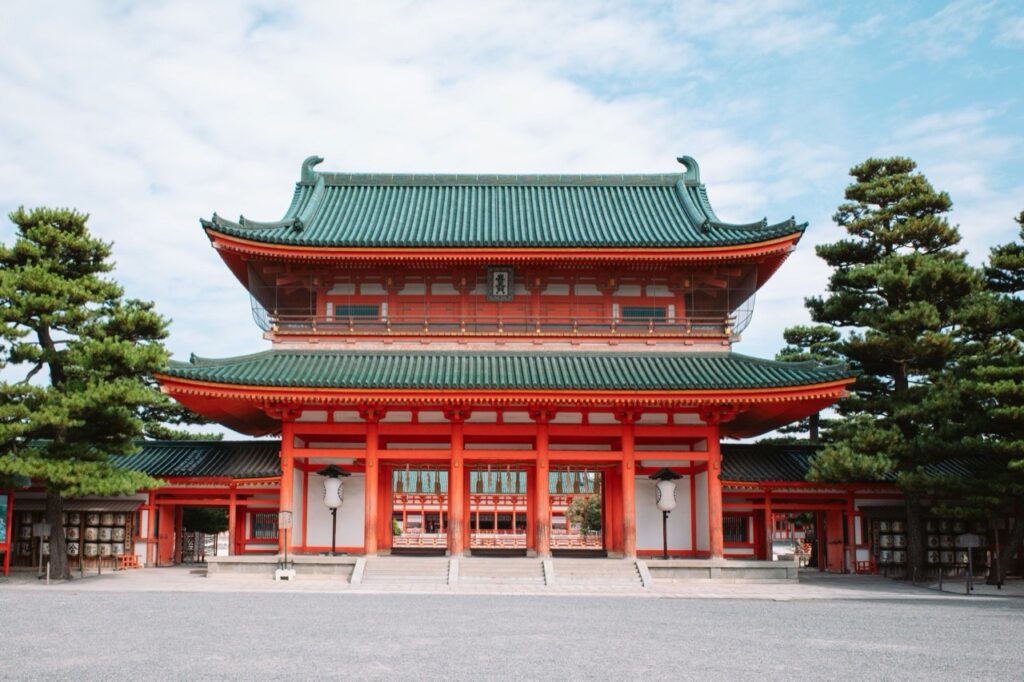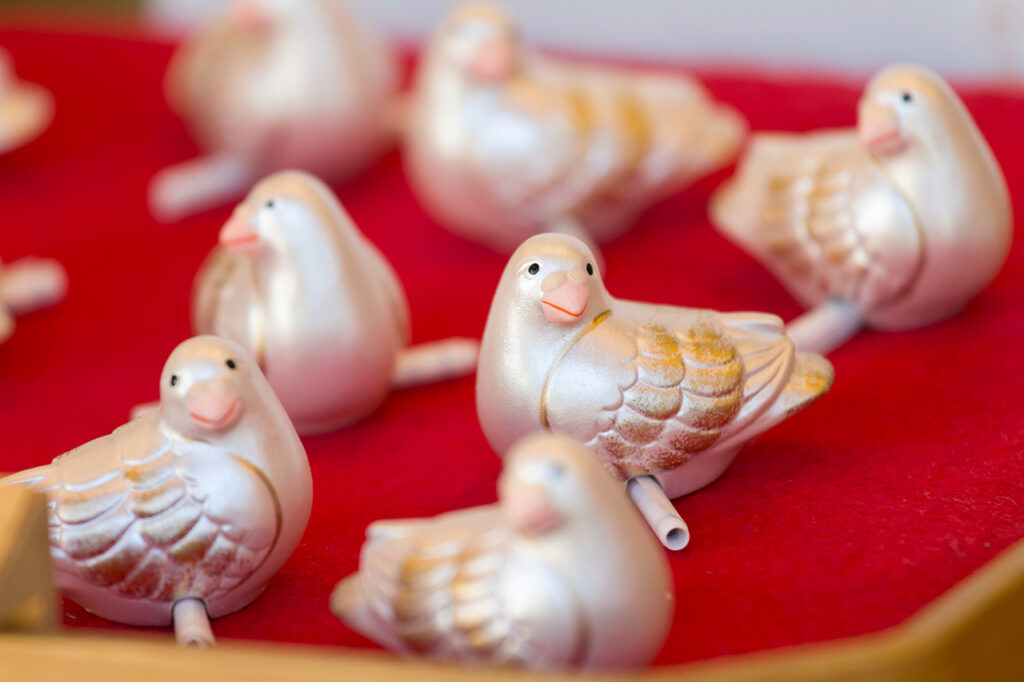
[2025] For a boost to your luck! Kyoto and Shiga, recommended by the ...
PR


Happy New Year!
Why not make New Year's a wonderful year by visiting Hatsumode (New Year's Pilgrimage)? In Kyoto, there are many old shrines with long histories and famous shrines that are familiar with historical figures. In this issue, we will introduce some trivia you should know in addition to information on special New Year's festivals and gifts! Let's offer our thanks for the past year and pray for a great leap forward and peace in the new year.
Yasaka Shrine is the head office of the Gion faithful who pray for protection from bad luck. The main deity "Susanoo-no-Mikoto" has been worshipped as a god to exorcise all kinds of misfortunes. The "Okera-mairi," a year-end tradition in Kyoto, is a New Year's Eve festival held here. During the period from around 7:30 p.m. on New Year's Eve to early morning on New Year's Day, visitors transfer the sacred fire, which was kindled through the night with "Okera-moku" (a tree on which people wrote their wishes), onto a fire rope and take it home with them. It is said that the fire rope, which is extinguished before leaving the shrine, should be displayed in the kitchen as a good luck charm against fire.
Tidbits you should know.
The main gate was rebuilt in 1879 after being destroyed by fire in 1866. The main gate is the starting point for the portable shrine procession and wedding ceremonies during the Gion Festival.
[Blessings
To ward off bad luck, to bring good luck, to ensure the safety of the family, etc.



ritual visit to a temple in which a new servant has his first audience (at a shrine, temple shrine, etc.)

Heian Jingu Shrine was built in the Meiji period (1868-1912) to commemorate the 1,100th anniversary of the relocation of the capital to Heian-kyo and to pass on to future generations the legacy of the many people who restored Kyoto to its former state. The shrine pavilions are approximately five-eighths the size of Chodoin, the main building of the Heian-kyo Capital when it was founded by Emperor Kammu, the deity of the capital, and allow visitors to experience the scenery of Kyoto 1,200 years ago. From New Year's Eve to New Year's Day, the gates are open all night and all the lanterns on the temple grounds are lit, creating a solemn and festive atmosphere. Get a "kamiya," a special New Year's gift, or a "kohaku zodiac sign protection" to pray for a safe and peaceful new year.
Tidbits you should know.
There is a limited red seal for the period from January 1 to 15, which features the Chinese zodiac sign for each year. There are also other red seals such as cherry blossom red seals limited to the cherry blossom season and red seals limited to the period of the Jidai Matsuri (festival of the ages).
[Blessings
Marriage, academic achievement, prosperous business, etc.



Shinya (large): 2,000 yen for the first earning, (small): 1,500 yen for the first earning / 1 red and white zodiac sign guard: 2,000 yen for the first earning

[Fushimi Inari Taisha is the head shrine of Inari shrines, of which there are said to be 30,000 throughout Japan. As a shrine of common people's faith, people have long prayed for a good harvest. In recent years, it has also been worshipped as the god of business prosperity and family safety. The vermilion color of the main shrine pavilion and torii (torii gate) represents the fertility of the power of the "Great God of Inari," and the white fox, the messenger of the god, is revered as "Byakko-san. Passing through the Senbon-torii gate and climbing Mt. Inari, you can enjoy a panoramic view of southern Kyoto, so make a pilgrimage to the mountain to bring in good fortune for the year ahead.
Tidbits you should know.
In addition to the familiar spots such as the Senbon-torii (1,000-torii gate), the tower gate, and the foxes that serve as messengers of the gods that reside here and there on the temple grounds, there are many other attractions such as the Omokaruseki, which predicts the fulfillment of wishes, and the Negami no Matsu, which is said to bring two blessings to the shrine. The Kumataka Shrine, the Ganryoku Shrine, and the Yakuriki Shrine are also well-known to those in the know as powerful power spots.
[Blessings
Prosperity in business, safety in the family, safe delivery, academic achievement, etc.



White Fox Ema (votive tablet), 1,000 yen for the first earning

Kitano Tenmangu Shrine is the headquarters of approximately 12,000 Tenmangu shrines and Tenjinsha throughout Japan that worship Sugawara no Michizane (Lord Suga). Suga is widely known as the "god of learning" because of his outstanding achievements as a poet and calligrapher. On January 2 every year, the "Hatsumae (beginning of brush writing) Festival" is held in memory of the deity and to pray for the improvement of calligraphy skills of those who are familiar with the art. From January 2 to 4, the "Tenmasho" ceremony is held to pray for the improvement of calligraphy by starting the first calligraphy in front of the god. Let's calm our minds and write in front of the "god of learning.
Tidbits you should know.
The present main shrine was built in 1607 by Hideyori, the third son of Toyotomi Hideyoshi. The golden ornamentation and vivid carvings show Hideyoshi's love of luxury. Look for the three pumpkins that Lord Hideyoshi had carved in hopes of prolonging his military fortune.
[Blessings
Academic achievement, protection against bad luck, cultural and performing arts, etc.

Kitano Tenmangu Shrine National Treasure Gohonden

-1024x682.jpg)
Fortune slip: 500 yen for the first offering

Shimogamo Shrine (Kamo Goso-jinja) is popularly known as "Shimogamo-san" because it is enshrined downstream of the Kamo River. The shrine has a history as old as 90 B.C., with a record of the repair of the shrine's Zuigaki fence. During the Heian period (794-1185), the shrine was specially worshipped as the guardian deity of the country and the capital city, Kyoto. Every year on January 4, "kemari," a game of football that was loved by the court, is dedicated to the god, allowing visitors to experience the history of Kyoto firsthand. Ehime-mamori" made of colorful crape cloth and "Lace-mamori" with beautiful delicate openwork patterns are available, so find your favorite one.
Tidbits you should know.
The "Kemari Hajime" is held on January 4 as one of the Shinto rituals, and the "Goroshi Matsuri" is held on January 15, the azuki bean porridge festival to purify the evil spirits of the year, and various other events are held throughout the year.
[Blessings
Marriage, safe childbirth, childcare, etc.



Ehime-mamori (first earning 1000 yen) / Race-mamori (first earning 2000 yen)

Ishimizu Hachimangu Shrine has been located in Otokoyama, a strategic location for transportation between Kyoto and Osaka, since 859 (Jougan era) as the guardian deity of the capital. The 10 main buildings and 3 munefuda were designated as National Treasures in 2016 as highly complete shrine architecture that retains the solemn form of the shrine buildings and also features modern-style decorations. The dove, a messenger of Hachiman-taijin, is also used as a fortune teller. Try to divine your fortune for the year with the "Hato-mikuji" in the grounds of the shrine, which is full of history and splendor.
Tidbits you should know.
In the Shinto garden, there is a monument to Edison, who succeeded in lighting an incandescent light bulb for an extended period of time using bamboo from Otokoyama.
[Blessings
Good luck, prosperous business, safe delivery, etc.



Hato-mikuji (dove fortune) 700 yen for the first offering

Seongnamiya Shrine was built on the occasion of the relocation of the capital to Heian (794-1192), and has a history of 1,230 years, praying for the safety of the capital and the protection of the country. The shrine has been revered since ancient times as a god of directional protection, and today it is widely worshipped as a guardian deity of traffic safety, family happiness, prevention of misfortune, and safety in daily life. Choose the one that best suits your wish from the "Directional Protection Amulet" that removes misfortune in the direction of the direction and the "Suzaku" amulet that prays for good luck and good health.
Tidbits you should know.
On the third day of the New Year, from 9:00 a.m. to 4:00 p.m., miko (shrine maidens) perform purification music on the front stage of the Kaguraden, with the sound of bells, to purify people who pay their first visit to the shrine, to remove bad luck, and to pray for good health.
[Blessings
Hoyoyoyu (protection from bad luck), traffic safety, family happiness, etc.



Amulet (Suzaku), 1,000 yen (left) / Houyaku amulet (octagonal shape), yellow, 1,000 yen (right)

Kibune Shrine is dedicated to the god Takanokami, who presides over the supply of water. It is said that the shrine was first built by the first Emperor Kammu, Tamayorihime-no-Mikoto, who traveled up the river by boat from Naniwa and enshrined a shrine there. Katsura trees, which are said to grow in places with abundant water, tower over the main shrine, the Yusha shrine, and the Okumiya shrine, from which the sacred water springs. Legend has it that Izumishikibu, a poet of the Heian period (794-1185), visited the shrine, and many people come to the shrine to seek a good marriage.
Tidbits you should know.
The main shrine of Okumiya is built over a huge hole called "Ryuketsu. The hole is considered sacred, and no one is allowed to touch it, but there is a story that a carpenter dropped his chisel into the hole during the Edo period (1603-1867), and a gust of wind caused the chisel to fly up into the air. It is a power spot that exudes sacred and mighty power, so check it out as well!
[Blessings
Fortune, marriage, and fulfillment of various wishes



New Year's Day

Kamowakeikazuchi-jinja Shrine is commonly known as Kamigamo Shrine. The deity is Kamo Betsurai-no-mikoto, who appears in mythology. It is said to be one of the oldest shrines in Kyoto, and the foundation of the shrine pavilions, which are almost identical to the present ones, was built in 677. The vast site, with its national treasures, the main shrine and gonden, and 41 important cultural properties, is registered as a UNESCO World Cultural Heritage site. Visitors are invited to pray for good luck and protection from bad luck at this important historical site.
Tidbits you should know.
In addition to the Chinese zodiac lottery, there are many other types of prizes, such as the "Kamo eggplant lottery," named after the Kyoto vegetable, Kamo eggplant, which is a specialty of the area, and the "horse lottery," which was created because the area is the birthplace of horse racing.
[Blessings
To ward off bad luck, to remove bad luck, to open the door to good fortune, etc.

Tower gate designated as a national important cultural property (photo courtesy of Kamigamo Shrine)


New Year's Day limited red seal, 1,000 yen for the first earning, available only from January 1 to 31, and will be discontinued as soon as it is gone (photo courtesy of Kamigamo Shrine).

Seimei Shrine was built in 1007 by order of Emperor Ichijo to honor the achievements of Lord Abe no Seimei and to repose his soul. Seimei was an astronomer of the Heian period (794-1185), and was famous as a shrine to ward off bad luck, as he predicted unusual events and good fortune before his death. The Seimei Well, which is said to be beneficial for healing illnesses, is said to have been created by the power of Seimei's will. The shrine's youngest branch is the Sai Inari Shrine, which enshrines Inari and two other deities, and there is a theory that Lord Seimei is the reincarnation of Inari.
Tidbits you should know.
Seimei Shrine is dedicated to Prince Abe no Seimei, the god of protection from evil and misfortune. The New Year's decorations at Seimei Shrine, which are decorated with a pentagram, a sign of protection from evil, are purified with hemp before the shrine and a prayer is offered.
[Blessings
To ward off bad luck, heal illness, and ensure the safety of the family, etc.



(Photo courtesy of Seimei Shrine)

Matsuo-taisha was founded in 701 by Hata-no-Imikitori at the order of Emperor Monmu [Matsuo-taisha]. Since the capital was moved to Nagaokakyo, the shrine has been worshipped as a shrine for the protection of the imperial castle. Since the Hata-no-Imikitori were a clan of Japanese immigrants who excelled at sake brewing, they are also worshipped as the god of sake. Go'ou-hoin (亀牛玉寶印) is a glorious seal made of woodblocks discovered in preparation for the "Matsuo Taisha Exhibition. It was decided that the seal would be awarded for the first time in about 150 years to pray for family safety and good health.
Tidbits you should know.
[Matsuo-taisha Shrine is a shrine with a variety of beneficial properties, but it is especially revered as the ancestral god of brewing, and is visited by sake brewers from all over the country.
[Blessings
Prosperity in business, fulfillment of love, family happiness and longevity, etc.



Turtle Gyu Gyokuhoin (Go'ou Houin), first earning 2,000 yen

[Kurumaori Shrine is dedicated to the Confucian scholar Kiyohara Yoriyoshi. Kiyohara Yoriyoshi was famous as a god of scholarship. Because of his honest character, the shrine is also known as a god who protects people's "faithful promises," and many people pray for prosperous business. The flower ceiling painted by Reiki Yamaguchi, a Japanese-style painter, is also a must-see. The shrine is also home to a performing arts shrine, which is frequented not only by people in the entertainment industry, but also by athletes who come to pray to the shrine to hone their craft and skills.
Tidbits you should know.
A shrine of purification where a huge conical stone is enshrined. It is said to be an image of standing sand, and is said to drive away bad karma and bring in good karma. It is said to be good to take a picture of it and wear it, and many people use it as a standby for their cell phones.
[Blessings
Fortune, prosperous business, good marriage, etc.



Ichiyo-rikaikou (1,000 yen for the first earning) The awarding period is from the winter solstice to Risshun (the first day of spring).

Over 600 interviews per year! An order site carefully selected by the editors who knows Kyoto and Shiga.
nowOfficial LINE friend registration500 yen OFF coupon is being issued!
Distributed every Friday morning at 8:00 am! From new restaurant information to event information that we want to share with you, We deliver articles about Kyoto that are useful to know. About 20,000 people have registered.Click here to add a friend!
 News
News Feature article
Feature article Featured event
Featured event